by Martin Laukkanen | Apr 9, 2014 | How to, Reporting
I’ve been looking forward to using the new SSIS OData Connector for SQL 2012 since first hearing about it at Project Conf last month, Paul Mather wrote up a great step-by-step guide on getting it all up and running here so have a look at that if you haven’t yet.
However the devil is always in the details! Creating a simple report combining Project data and SharePoint site data is not as straight-forward as you might hope.
Reporting custom project site list data from ProjectOnline
Possibly the most common customer request I get when it comes to reporting is the need to report against non-standard Project site list data, something that was simple using SSRS 2008 R2 but made impossible in ProjectOnline, until now that is.
Following on from Paul’s post, in order to do this you’ll need an SSIS package that does the following:
- Retrieve Project Data from the ProjectOnline OData endpoint: /_api/ProjectData
- Get a list of Project Site URLs from the data and save it in a variable
- Loop through each Project Site and retrieve data from the SharePoint endpoint: /[ProjectURL]/_vti_bin/listdata.svc after dynamically updating the [ProjectURL]
Also you’ll notice there in step 3 I use the listdata.svc endpoint rather than the REST endpoint (e.g. /_api/Web/Lists/getbytitle(‘Risks’)/Items), if you followed Paul’s steps above and tried to retrieve the site list data then you probably are seeing the following error when building the connection:
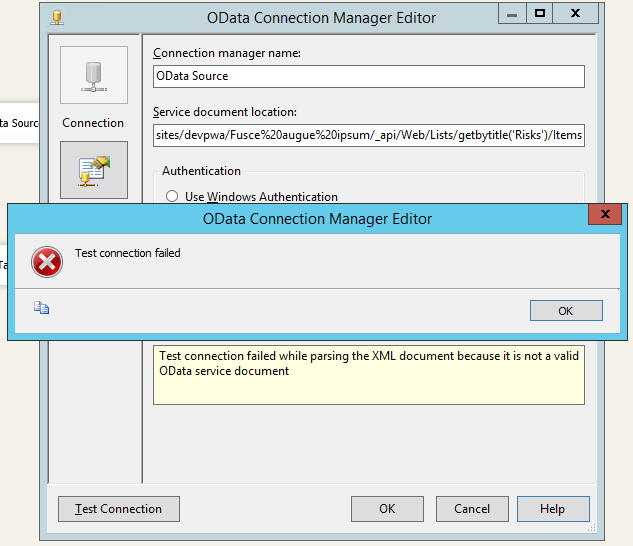
Error message:
Test connection failed while parsing the XML document because it is not a valid OData service document.
If you’re seeing that message it is because the SSIS connector is expecting a ‘service document’ and not the actual OData feed. Not sure why the SharePoint REST endpoints don’t also have a service document at the root but we can work around it by using the listdata.svc.
Finally once we have the list of all of the Project site URLs then we need to update the Data Connection URL before we retrieve the site list data. I’ll cover all of these steps below.
Requirements for building the SSIS package
Paul Mather’s blog covers the basic setup, so I won’t cover that in detail but in summary to create / use the solution below you will need:
- SQL Server Integration Services 2012
- SQL Data Tools 2012 (the BIDS replacement on the SQL DVD)
- Microsoft® OData Source for Microsoft SQL Server® 2012
- SharePoint Server 2013 Client Components SDK
- An empty SQL database to write to, I’m going to use one called ProjectOnline_OData
You can run Data Tools on your client but the rest must be installed on the SSIS server.
Creating a SSIS package to retrieve site custom list for all projects
Create a new SSIS package and to start by adding the following Connection Managers:
- OLE DB Connection which points to your SQL database: e.g. ProjectOnline_OData
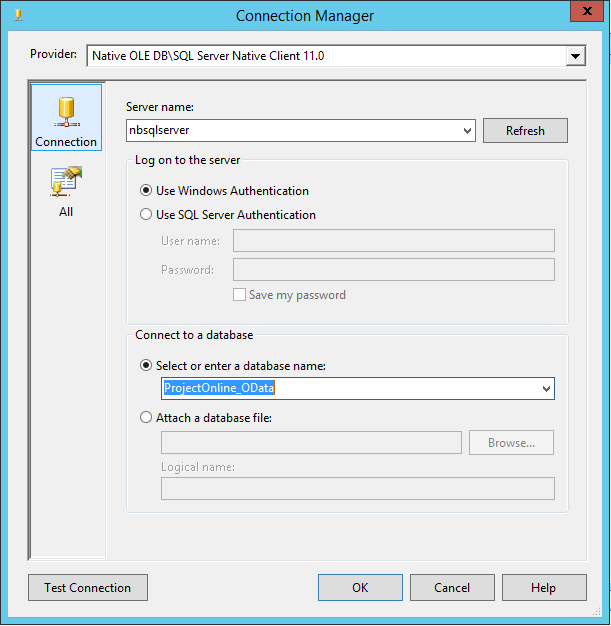
- An OData Connection pointing to the ProjectData OData service: e.g.
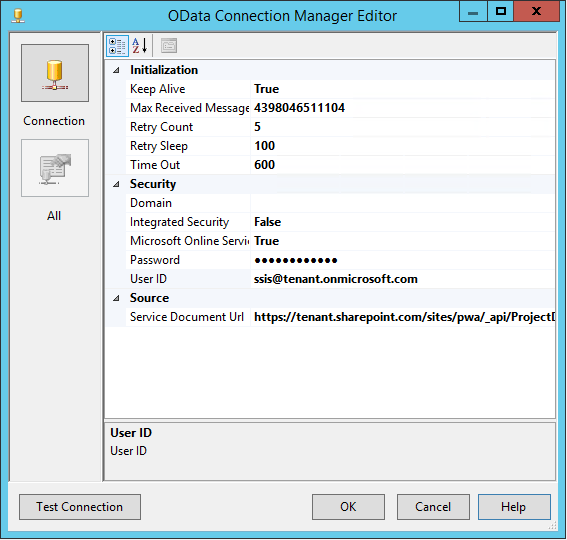
- An OData Connection pointing to the SharePoint ListData.svc OData service of an existing project site: e.g. Test%20Project/_vti_bin/listdata.svc
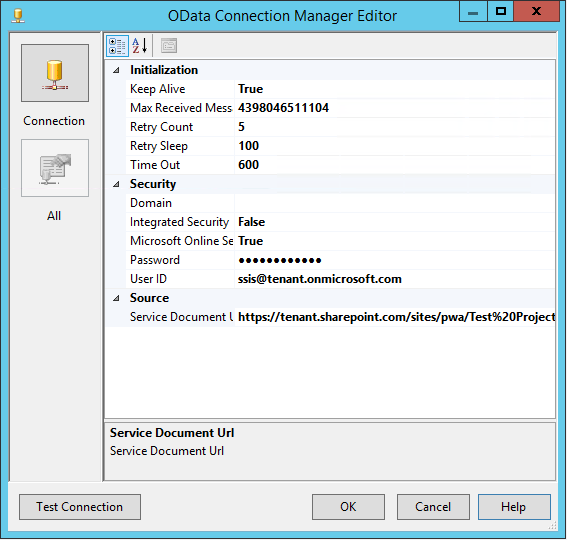
Make sure that each connection test’s successfully, and give them descriptive names which will be used later. I’m using OData_ProjectData and OData_SharePointListData for the last two and note that both names will be referenced below.
A note on security
The account used to authenticate with our OData connections must be a ProjectOnline user, and specifically it must have access to all projects and project sites. In order to do this easily I have added the users ([email protected]) to the following:
- Project Web App Administrators
- Site Collection Administrators
Adjust as you see fit.
Retrieve project data from OData
Now that we have our data connections we need to first get our Project data (and optionally any other data such as tasks), then prepare to get our project site data.
- As per Paul’s blog create a Data Flow task with an OData Source (OData_ProjectData) which points to the Projects collection.
- Ensure that you select only your required Columns, however you must include the following as a minimum: ProjectId & ProjectWorkspaceInternalUrl.
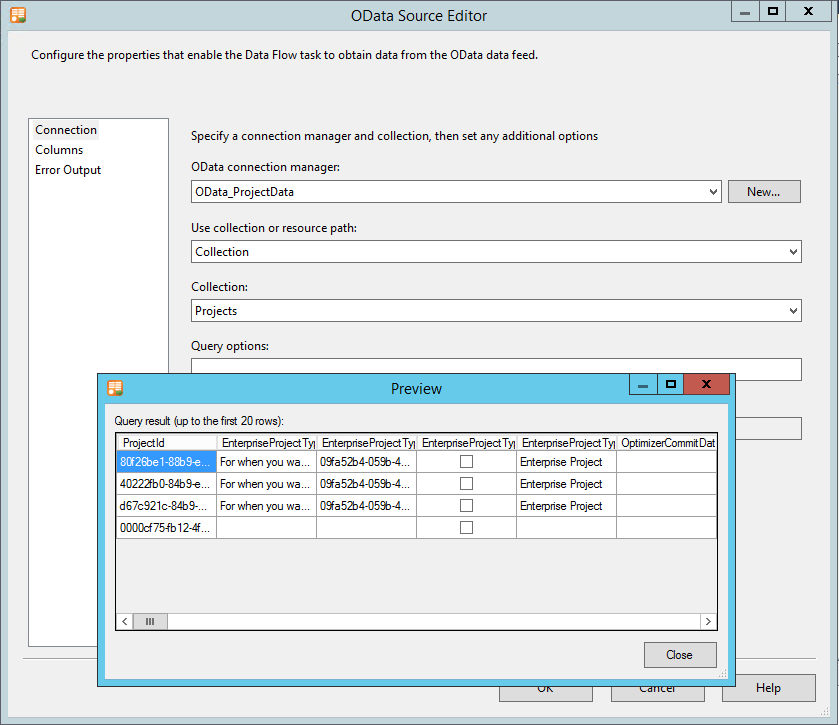
Projects collection OData source with preview
- Use the Destination Assistant to create the destination database
- Create a new table to store the data in (I’m using the name Projects) and configure your mappings
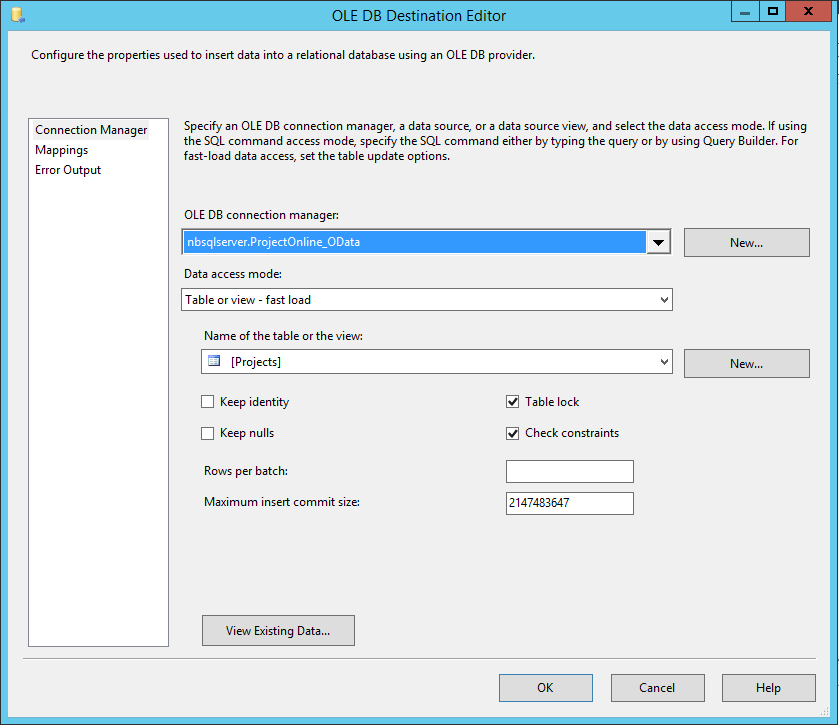
- Optionally you could add other Data Flow tasks in there to get Tasks or other data into additional database tables, but only using the OData_ProjectData connection at this point.
So now you should have a solution that runs and looks something like this when debugging:

Also if you started with Paul’s blog, then this is where those steps end.
Prepare to loop through all project sites
In order to get the site list data for each project in PWA we need to first save a temporary variable with a list of all ProjectWorkspaceInternalUrl‘s.
- In your solution on the Control Flow tab add another Data Flow Task. Link the green arrow from the previous task to this one (so runs 2nd)
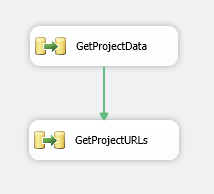
- Add an OLE DB Source to the Data Flow using the Source Assistant
- This source will be configured to get project url’s saved into our database in the last step using the following SQL command:
SELECT ProjectId, ProjectWorkspaceInternalUrl
FROM Projects
WHERE (ProjectWorkspaceInternalUrl IS NOT NULL)
So it looks like;
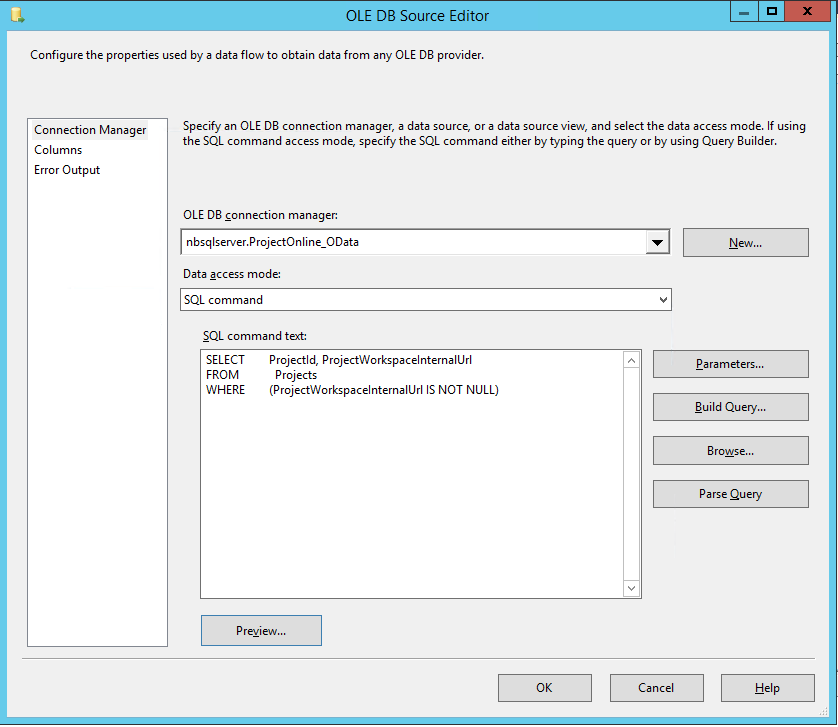
Create a temporary variable to store URLs
- Open the Variables window in Visual Studio (it’s one of the icons top right above the package area.
- Add a variable called ProjectList and set the Type to Object

- Now add a Recordset Destination to the data flow and link the blue arrow from our OLE Source to it
- In the advanced properties specify the VariableName just created.
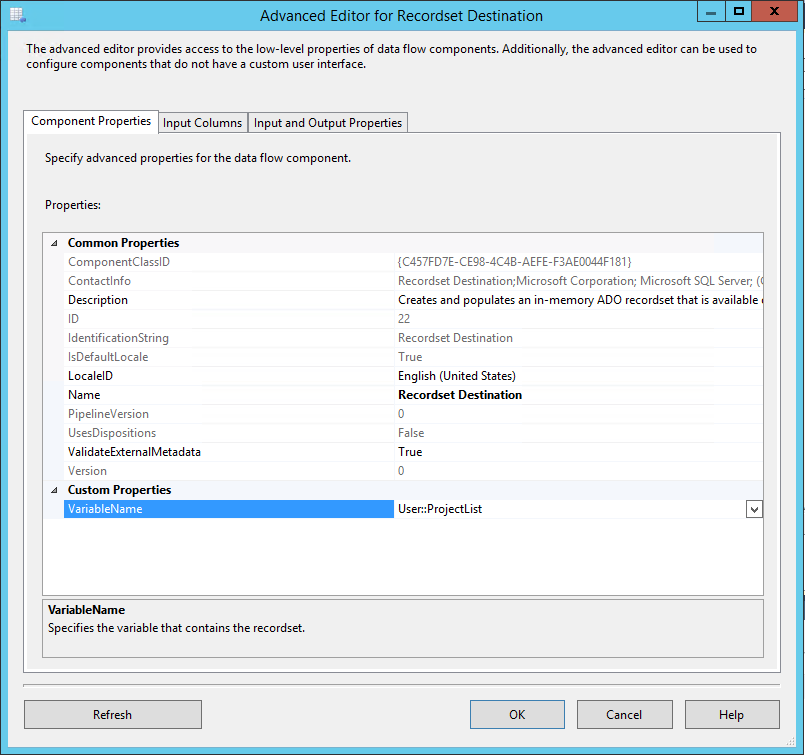
- On the Input Columns tab select all columns
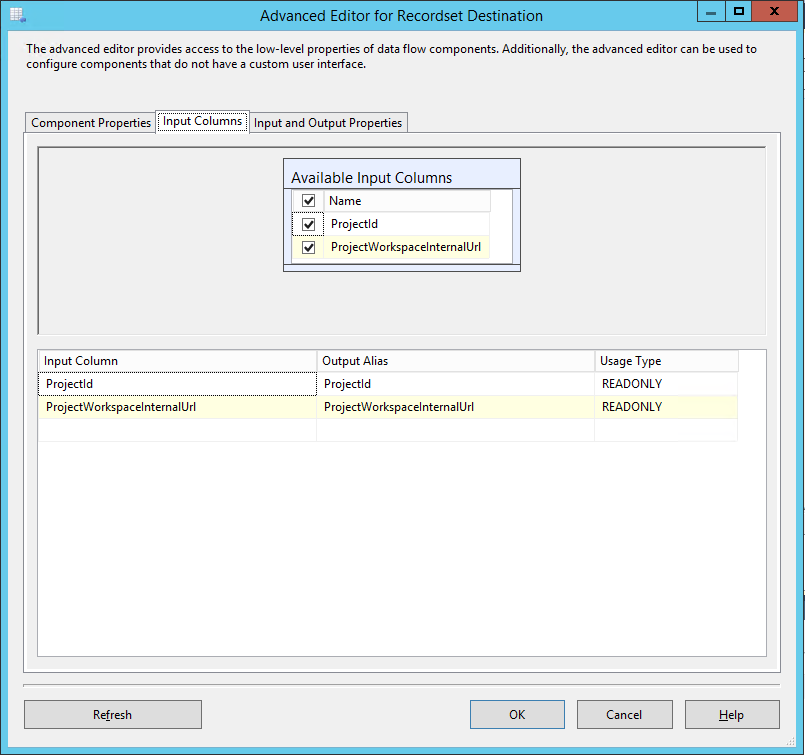
All other settings can be left with defaults. The Data Flow task should now look like this;

Create a Foreach loop to iterate through sites
Now we’re getting to the tricky part, SSIS enables this kind of iteration nicely, however we need to do a couple of special things to work with our OData list data, specifically update the datasource URL to the next project and extend the returned data by adding the ProjectId field of the project (for our FK).
- Firstly add two new Variables to the package; ProjectId and ProjectUrl, both as type String

- Next drag in a Foreach Loop Container and connect the green arrow from the previous item to it
- In the Collection properties of the Foreach Loop select Foreach ADO Enumerator and specify the User::ProjectList variable created earlier
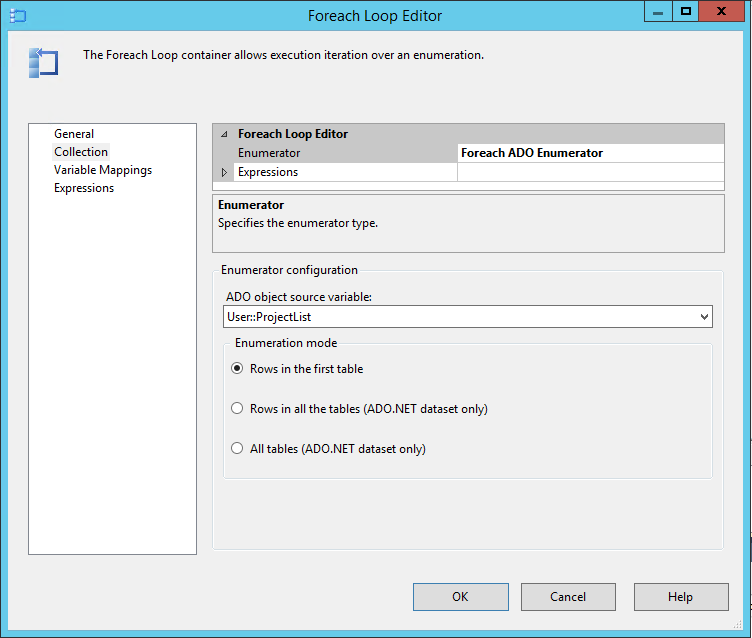
- Next under Variable Mappings specify our other variables in the following index order: Index 0 – User:ProjectId, Index 1 – User::ProjectURL, (Note this order is important and used in the Foreach below!)
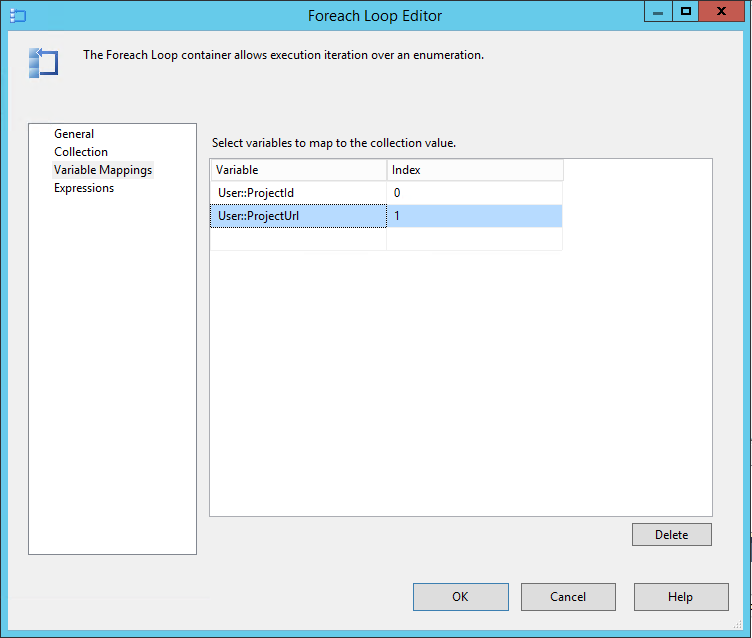
Update the SharePoint Listdata datasource URL
The first action inside our Foreach loop must be to update the connection string property of our SharePoint listdata dataconnection created at the beginning. Don’t run away but we’ll do this using a Script Task and a few lines of code.
- Drop a Script Task inside the Foreach loop container
- In the properties make sure the ScriptLanguage is Visual C# 2010
- Then add a ReadOnlyVariable pointing to User::ProjectUrl
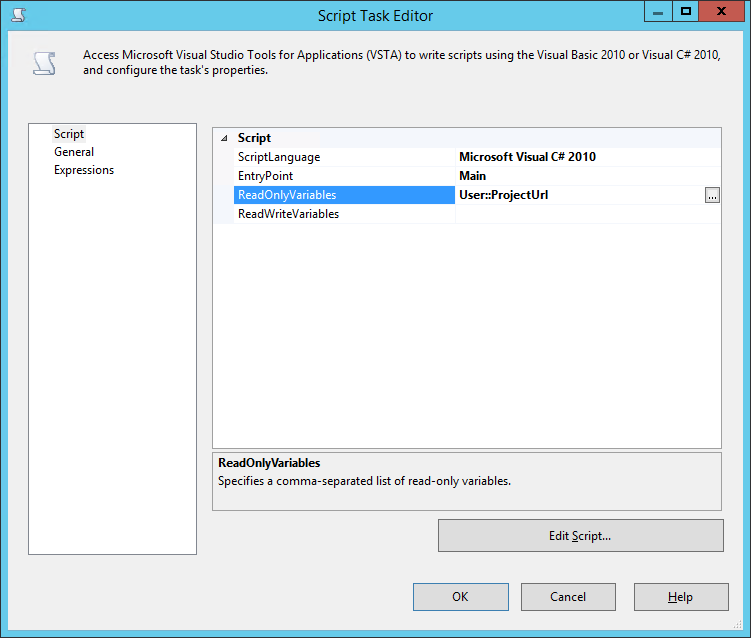
- Click Edit Script and we’ll be replacing the Main() block with the following code:
public void Main()
{
// TODO: Add your code here
String ProjectURL = (String)Dts.Variables[0].Value;
Dts.Connections["OData_SharePointListData"].ConnectionString =
System.Text.RegularExpressions.Regex.Replace(
Dts.Connections["OData_SharePointListData"].ConnectionString,
"https://.*(?=/_vti_bin/listdata.svc)",
ProjectURL);
Dts.TaskResult = (int)ScriptResults.Success;
}
IMPORTANT NOTE: In that code we reference the OData_SharePointListData connection by name which we created way back in the first step! So if you used another name make sure you update both references to that name in the code.
Save and close that script window and we can move on to the last couple of steps.
Getting project site data from each site
- Add a Data Flow Task after the script task inside the Foreach loop container, and link the green arrow from the script task to the data flow task
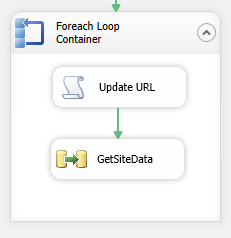
- In the Data Flow tab for this item, first add an OData Source
- Configure the source using the OData_SharePointListData source created and specify the required collection (I’m using Risks for the sake of this demo)
- Select the desired columns and preview to test

Note here that I’m able to see the values in the test project site that I specified right back at the beginning, however when the solution executes the URL will have been updated before this step. Whenever you edit this solution in the future this site must be valid and accessible else you will get errors here.
Next we need to add our project server ProjectId to the data coming from OData so we can use it is a foreign key in the destination database table.
- Drag a Derived Column to the canvas link it 2nd and edit the properties
- Add a Derived Column Name as ProjectId
- From the Variables and Parameters drag the User::ProjectId into the Expression box
- Lastly (importantly) from the Type Casts list drag the (DT_GUID) item to the start of the expression so it is exactly: (DT_GUID) @[User::ProjectId]

- Now finally use the Destination Assistant to create and configure our Risks database table where the data will be saved
- Configure the mappings as required, and double check that ProjectId has automatically been mapped
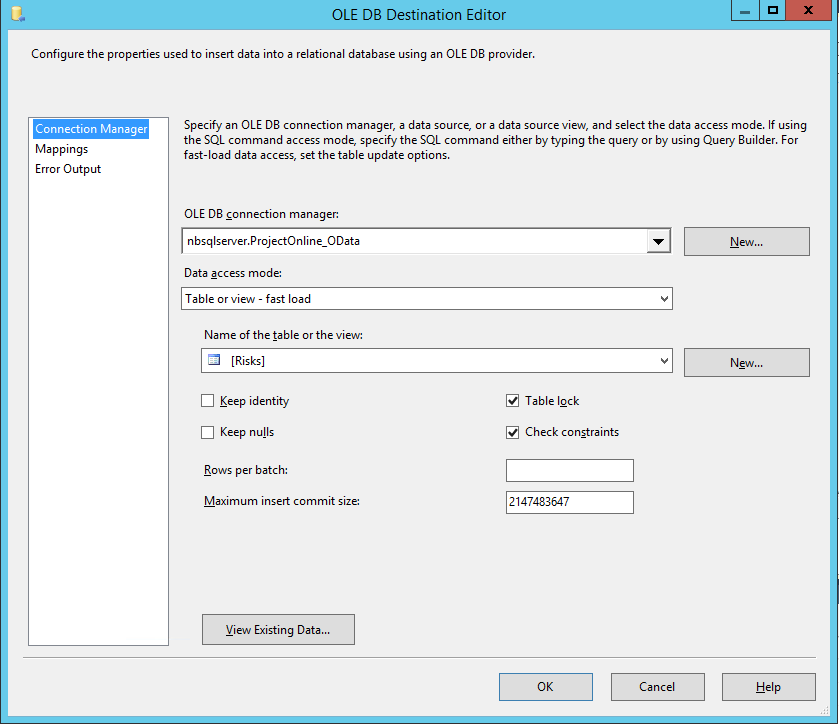
We’re just about done, that Data Flow should now look like this:

Final touches
The solution should now run and work as expected, with only one catch, each time you run it it will append all of the data again, so for a quick (hackish) solution to that the final step here is to add a step to the very beginning to delete existing data in our report database.
- On the Control Flow tab add one more Execute SQL Task to the top of the canvas and make our first GetProjectData follow it.
- Edit the properties and select our temp database ProjectOnline_OData as the Connection
- Then set the following as the SQL Query (Note: Don’t use Build Query as that won’t let you cut and paste, just paste it into the SQLStatement field
DELETE FROM Projects WHERE 1=1
DELETE FROM Tasks WHERE 1=1
DELETE FROM Risks WHERE 1=1
- No other options need be changed
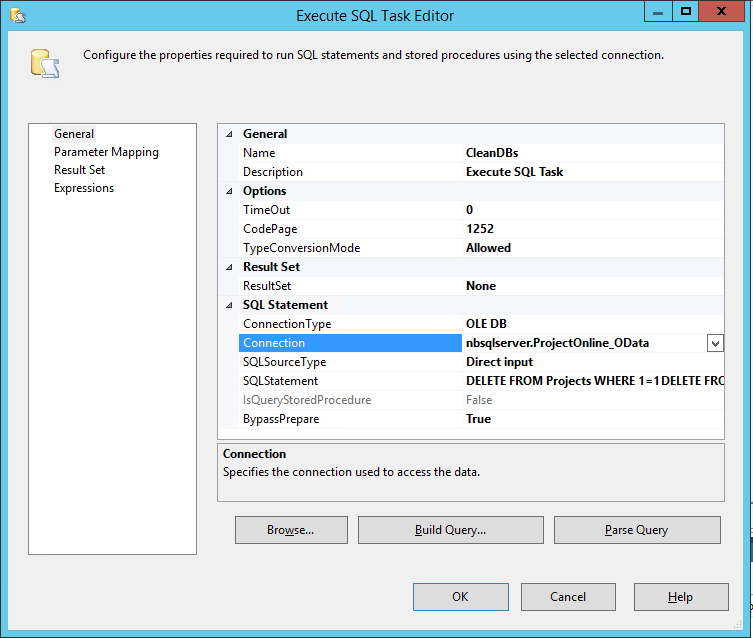
Done, test it out and it should run and look something like this when run:
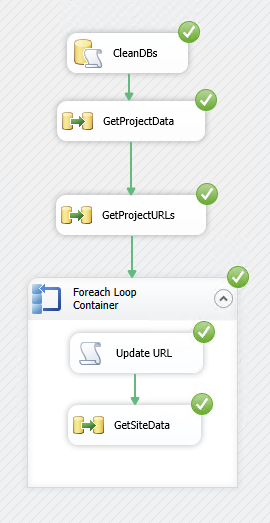
Final words
That was easy, wasn’t it? Aren’t we all glad to not need the SSRS SharePoint list datasource anymore! *ahem* [sarcasm]
Well now that you have your data-warehouse of project data and all artifacts, that should make your SSRS report writing not only simpler but actually much faster performing.
Download Source
Download this full solution here and any post any questions below.
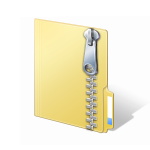
ProjectOnline_OData.zip
To use this you will need to update all your data-connections and recreate the destination Tables (as per steps above).
by Martin Laukkanen | Mar 26, 2014 | Apps, Development, How to
Another great thing to come out of Project Conf for me was the connections with people working on some of the same problems that I’ve faced, this is one of those; updating Projects which are checked out is not possible using the same old method that was used with the PSI! (Think about the problem this creates for PDP App Parts!)
Fortunately it is possible thanks to the following undocumented method discovered by Martin Petersen on his blog here:
http://projectserverinsights.blogspot.dk/2014/03/update-project-from-apppart.html
Check it out, and thanks Martin for the solution!
by Martin Laukkanen | Feb 8, 2014 | Apps, Development, How to
In this final part of the series we’re going to complete the holiday sync app by importing the selected calendar exceptions into Project Server.
We’ll start from where we finished up in Part 2 with our app loading data from both existing project server calendars and our external web service, so to follow this article make sure you start with the solution from the end of Part 2.
Part 3: Importing data into Enterprise Calendars from our App
Now that we have a list of calendar exceptions that we want to import we need to use some JSOM to actually import those exceptions.
To break-down what we need to do here I’m going to review this JSOM in three steps;
Step 1 Prepare context and get objects to update
// Get the Project Server context
var projContext = PS.ProjectContext.get_current();
// Get our Calendar Collection
var eCalColl = projContext.get_calendars();
var eCalendar = eCalColl.getByGuid(calUid);
var eCalBaseExcep = eCalendar.get_baseCalendarExceptions();
In step 1 we instantiate our object variables using the PS.js JSOM library to first get our calendar collection, then get our calendar by GUID from that collection and finally we get our base calendar exceptions from our calendar.
Next we’ll update those collections.
Step 2 Create the exception(s)
// Step 2 Loop through and add each exception
for (var i = 0; i < exceptions.length; i++) {
var excepInfo = new PS.CalendarExceptionCreationInformation();
// Set the exception properties
excepInfo.set_name(exceptions[i].Descriptor);
excepInfo.set_start(exceptions[i].Date);
excepInfo.set_finish(exceptions[i].Date);
// Finally add the exception info to the base calendar object
eCalBaseExcep.add(excepInfo);
}
// Update the collection
eCalColl.update();
Now we’re going to create each calendar exception using the PS.CalendarExceptionCreationInformation constructor, you’ll find one of those constructors for most of the objects in JSOM, if you want more on this see MSDN; http://msdn.microsoft.com/en-us/library/office/jj669390.aspx.
Once we have our excepInfo object we set the required properties; Name, Start and Finish, then finish by adding that item to our exception collection before moving to the next exception to be added. Finally we update the calendar collection object with all the exceptions created.
Now as we’re working asynchronously the last step is to execute the above update(s);
Step 3 Update the calendar asynchronously
// Finally asynchronously execute the update
projContext.executeQueryAsync(Function.createDelegate(this, function () {
// Success update our grid and finish up
this.grid.setSelectedRows([]);
// Display the results and remove the progress msg
SP.UI.Notify.addNotification("Exceptions added successfully", false);
}), Function.createDelegate(this, function (call, error) {
// Handle Error
alert(error.get_message());
}));
So using the JSOM executeQueryAsync function we execute the change and handle the result, here we simply want to notify the user of the result.
Full code block follows, paste this into the bottom of the App.js:
// Function to add calendar exceptions via JSOM
HolidaySync.prototype.addCalendarException = function (calUid, exceptions) {
// Show a progress message
this.notifyMsg = SP.UI.Notify.addNotification('<img src="/_layouts/images/loadingcirclests16.gif" style="vertical-align: top;"/> Importing...', true);
// Step 1 Get the Project Server context and objects
var projContext = PS.ProjectContext.get_current();
// Get our Calendar Collection
var eCalColl = projContext.get_calendars();
var eCalendar = eCalColl.getByGuid(calUid);
var eCalBaseExcep = eCalendar.get_baseCalendarExceptions();
//CSOM Ref (no JSOM): http://msdn.microsoft.com/en-us/library/office/microsoft.projectserver.client.calendarexceptioncollection_di_pj14mref_members.aspx
// Step 2 Loop through and add each exception
for (var i = 0; i < exceptions.length; i++) {
// Create our Calendar Exception Info
//http://msdn.microsoft.com/en-us/library/office/jj669390.aspx
var excepInfo = new PS.CalendarExceptionCreationInformation();
// Append the year to the name to prevent future duplicates
var exName = exceptions[i].Descriptor + " " + new Date(exceptions[i].Date).getFullYear();
// Set the exception properties
excepInfo.set_name(exName);
excepInfo.set_start(exceptions[i].Date);
excepInfo.set_finish(exceptions[i].Date);
// Finally add the exception to the collection
eCalBaseExcep.add(excepInfo);
}
// Update the collection
eCalColl.update();
// Step 3 Asynchronously execute the update
projContext.executeQueryAsync(Function.createDelegate(this, function () {
// Success update our grid and finish up
this.grid.setSelectedRows([]);
// Display the results and remove the progress msg
SP.UI.Notify.addNotification("Exceptions added successfully", false);
SP.UI.Notify.removeNotification(this.notifyMsg);
}), Function.createDelegate(this, function (call, error) {
// Handle Error
SP.UI.Notify.removeNotification(this.notifyMsg);
alert(error.get_message());
}));
};
Final bit: Import Button
Okay we’re almost done, just one last thing to do and that is to handle the click of the import button. A bit of jQuery will handle that for us, and in which we need to do just one more thing which is to check for any duplicates being imported to prevent import errors.
Paste the following in the main code block of App.js (should be right after the ‘$(“#importBtn”).click(…’ function:
// Button to import selected exceptions
$("#importBtn").click(Function.createDelegate(this, function () {
var selectedRows = holidaySync.grid.getSelectedRows();
// Use helper function to check for any duplicates before importing
var exceptionsToImport = Helpers.removeDuplicates(selectedRows, holidaySync.data);
// Import the exceptions
if (exceptionsToImport.length > 0) {
holidaySync.addCalendarException(holidaySync.data.calendarId, exceptionsToImport);
}
else {
// Mark all existing
holidaySync.grid.setSelectedRows([]);
alert("All selected exceptions already exist.");
}
}));
What we need to do in that function is call our removeDuplicates helper function which was created back in part 1 of this series. The function will return a filtered array of exceptions that we can then pass as a parameter to our addCalendarException function.
Now we should be able to test it and see the following:

All Done
This app documented here is now available on the SharePoint App store, so please rate it if you use it!
Source Download / Repository
You can browse or download the full source code for the completed app on the following GitHub repository:
https://github.com/martinlaukkanen/holidaysync
by Martin Laukkanen | Feb 8, 2014 | Apps, Development, How to
Following on from Part 1 of this series in which we setup our Holiday Sync app solution in Visual Studio including all pre-requisites, we now have a basic app web page looking the part and containing all controls functioning but without any actual data. In this next part we are going to look into getting that data into our app.
Part 2: Getting data into our Holiday Sync App
The Holiday Sync App is designed to update existing Project Server enterprise calendars with data retrieved from an external web service, so specifically our app will require the following data:
- From our Project tenant / instance we need enterprise calendar data
- From an external web service we require holiday data
Let’s look at each in turn to see what’s needed to retrieve and utilise the data.
Retrieving Enterprise Calendar Data
In order to update our Enterprise Calendars we firstly need to know some details about them including the names, GUIDs, etc. But secondly as mentioned in part 1 of this series when we looked at our helper script, we need to first remove any duplicates else our import will fail, so to do that we need to get a list of existing base calendar exceptions to compare against.
Getting enterprise data via REST endpoint
Now when working with Project Server data be it online or on-premises an extremely useful resource in 2013 is the REST endpoint, similar to the ODATA endpoints they enable you to quickly view the back-end data in Project Server or SharePoint.
To demonstrate this open your PWA tenant and browse to the following URL (note the _api/ProjectServer/ part which differs from the OData URL):
https://[mytenantname]/sites/devpwa/_api/ProjectServer/Calendars
And what you should see is something like this:
<?xml version="1.0" encoding="utf-8" ?>
<feed xml:base="https://*****.sharepoint.com/sites/devpwa/_api/" xmlns="http://www.w3.org/2005/Atom" xmlns:d="http://schemas.microsoft.com/ado/2007/08/dataservices" xmlns:m="http://schemas.microsoft.com/ado/2007/08/dataservices/metadata" xmlns:georss="http://www.georss.org/georss" xmlns:gml="http://www.opengis.net/gml">
<id>194a1d9e-fae6-4db7-8ef3-330508bd7ee2</id>
<title />
<updated>2014-02-02T21:48:33Z</updated>
<entry>
<id>https://****.sharepoint.com/sites/devpwa/_api/ProjectServer/Calendars('fb512eeb-027f-e311-be84-c48508b296a1')</id>
<category term="PS.Calendar" scheme="http://schemas.microsoft.com/ado/2007/08/dataservices/scheme" />
<link rel="edit" href="ProjectServer/Calendars('fb512eeb-027f-e311-be84-c48508b296a1')" />
<link rel="http://schemas.microsoft.com/ado/2007/08/dataservices/related/BaseCalendarExceptions" type="application/atom+xml;type=feed" title="BaseCalendarExceptions" href="ProjectServer/Calendars('fb512eeb-027f-e311-be84-c48508b296a1')/BaseCalendarExceptions" />
<title />
<updated>2014-02-02T21:48:33Z</updated>
<author>
<name />
</author>
<content type="application/xml">
<m:properties>
<d:Created m:type="Edm.DateTime">2014-01-16T15:07:18.94</d:Created>
<d:Id m:type="Edm.Guid">fb512eeb-027f-e311-be84-c48508b296a1</d:Id>
<d:IsStandardCalendar m:type="Edm.Boolean">false</d:IsStandardCalendar>
<d:Modified m:type="Edm.DateTime">2014-02-02T10:30:18.743</d:Modified>
<d:Name>Night Shift</d:Name>
</m:properties>
</content>
</entry>
<entry>
<id>https://****.sharepoint.com/sites/devpwa/_api/ProjectServer/Calendars('b6635b2e-e747-4771-a78b-24f7509629d0')</id>
<category term="PS.Calendar" scheme="http://schemas.microsoft.com/ado/2007/08/dataservices/scheme" />
<link rel="edit" href="ProjectServer/Calendars('b6635b2e-e747-4771-a78b-24f7509629d0')" />
<link rel="http://schemas.microsoft.com/ado/2007/08/dataservices/related/BaseCalendarExceptions" type="application/atom+xml;type=feed" title="BaseCalendarExceptions" href="ProjectServer/Calendars('b6635b2e-e747-4771-a78b-24f7509629d0')/BaseCalendarExceptions" />
<title />
<updated>2014-02-02T21:48:33Z</updated>
<author>
<name />
</author>
<content type="application/xml">
<m:properties>
<d:Created m:type="Edm.DateTime">2007-04-26T19:15:13</d:Created>
<d:Id m:type="Edm.Guid">b6635b2e-e747-4771-a78b-24f7509629d0</d:Id>
<d:IsStandardCalendar m:type="Edm.Boolean">true</d:IsStandardCalendar>
<d:Modified m:type="Edm.DateTime">2014-02-02T09:57:25.097</d:Modified>
<d:Name>Standard</d:Name>
</m:properties>
</content>
</entry>
</feed>
This shows the calendars in this particular instance of PWA, in short this is what you have in the published database in Project Server (TIP: A neat troubleshooting tool for any Admin as a matter of fact!). However one thing that’s missing above is the “BaseCalendarExceptions” data which is referenced as a link in the XML, for example “ProjectServer/Calendars(‘b6635b2e-e747-4771-a78b-24f7509629d0’)/BaseCalendarExceptions”.
Fortunately it’s easy enough to also get that in one query using the $expand REST option:
https://[mytenantname]/sites/devpwa/_api/ProjectServer/Calendars?$expand=BaseCalendarExceptions
Below is a snippet of an exception that is returned in addition to the above XML:
[snip]
<entry>
<id>https://****.sharepoint.com/sites/devpwa/_api/ProjectServer/Calendars('fb512eeb-027f-e311-be84-c48508b296a1')/BaseCalendarExceptions(0)</id>
<category term="PS.BaseCalendarException" scheme="http://schemas.microsoft.com/ado/2007/08/dataservices/scheme" />
<link rel="edit" href="ProjectServer/Calendars('fb512eeb-027f-e311-be84-c48508b296a1')/BaseCalendarExceptions(0)" />
<link rel="http://schemas.microsoft.com/ado/2007/08/dataservices/related/Calendar" type="application/atom+xml;type=entry" title="Calendar" href="ProjectServer/Calendars('fb512eeb-027f-e311-be84-c48508b296a1')/BaseCalendarExceptions(0)/Calendar" />
<title />
<updated>2014-02-02T22:44:25Z</updated>
<author>
<name />
</author>
<content type="application/xml">
<m:properties>
<d:Finish m:type="Edm.DateTime">2013-12-25T00:00:00</d:Finish>
<d:Id m:type="Edm.Int32">0</d:Id>
<d:Name>Christmas 2013</d:Name>
<d:RecurrenceDays m:type="Edm.Int32">0</d:RecurrenceDays>
<d:RecurrenceFrequency m:type="Edm.Int32">1</d:RecurrenceFrequency>
<d:RecurrenceMonth m:type="Edm.Int32">0</d:RecurrenceMonth>
<d:RecurrenceMonthDay m:type="Edm.Int32">0</d:RecurrenceMonthDay>
<d:RecurrenceType m:type="Edm.Int32">0</d:RecurrenceType>
<d:RecurrenceWeek m:type="Edm.Int32">0</d:RecurrenceWeek>
<d:Shift1Finish m:type="Edm.Int32">0</d:Shift1Finish>
<d:Shift1Start m:type="Edm.Int32">0</d:Shift1Start>
<d:Shift2Finish m:type="Edm.Int32">0</d:Shift2Finish>
<d:Shift2Start m:type="Edm.Int32">0</d:Shift2Start>
<d:Shift3Finish m:type="Edm.Int32">0</d:Shift3Finish>
<d:Shift3Start m:type="Edm.Int32">0</d:Shift3Start>
<d:Shift4Finish m:type="Edm.Int32">0</d:Shift4Finish>
<d:Shift4Start m:type="Edm.Int32">0</d:Shift4Start>
<d:Shift5Finish m:type="Edm.Int32">0</d:Shift5Finish>
<d:Shift5Start m:type="Edm.Int32">0</d:Shift5Start>
<d:Start m:type="Edm.DateTime">2013-12-25T00:00:00</d:Start>
</m:properties>
</content>
</entry>
[snip]
Once again that’s basically the raw data that we need in one simple URL request, simple isn’t it? Okay so how do you use that in the app?
Using a jQuery AJAX request to retrieve data
Now we need to use a bit of jQuery where-by we can create an AJAX request to simply download that data directly.
// Function to retrieve a list of Enterprise calendars and exceptions
HolidaySync.prototype.getEntCalData = function () {
//Example: http://server/PWA/_api/ProjectServer/Calendars?$expand=BaseCalendarExceptions
var url = _spPageContextInfo.webServerRelativeUrl + "/_api/ProjectServer/Calendars?$expand=BaseCalendarExceptions";
$.ajax({
url: url,
type: "GET",
context: this,
contentType: "application/json",
headers: { "ACCEPT": "application/json;odata=verbose" },
success: function (data, status, xhr) {
// Save our data
this.data.entCalendars = data.d.results;
// Populate our html dropdown list of calendars when data is ready
for (var i = 0; i < this.data.entCalendars.length; i++) {
$("#eCalendarSelect").append($('<option>', {
value: this.data.entCalendars[i].Id,
text: this.data.entCalendars[i].Name
}));
}
// Also set the default value
$("#eCalendarSelect").trigger("change");
},
error: function (error) {
// Handle error
alert("Error: " + error.statusText + " loading Enterprise Calendars");
}
});
};
The ajax function takes a few parameters, importantly:
- The URL – Which is identical to what we used above, ONLY that we have replaced our server name with the global property _spPageContextInfo.webServerRelativeUrl which equates to our App Domain (Not the tenant domain!)
- The content type which we set to JSON (more on this in a sec)
- And critically the success / failure handler functions to deal with the result
If we drill into the success function, we can see the following happening:
- Firstly we save our data back to the datamodel, notice here that because we can request JSON data we don’t need to do anything to the result but save it to our array previously instantiated (in part 1).
- Next we populate our html drop-down list with the data using a for loop and some basic jQuery.
- Finally we trigger the change event on the control to ensure that the view and model update.
Finally before we can preview we just have to start the above function in the appropriate place in our app, for that add the below line into the existing main code block (before the closing “});”) in the App.js file.
holidaySync.getEntCalData();
Now hit F5 to preview:
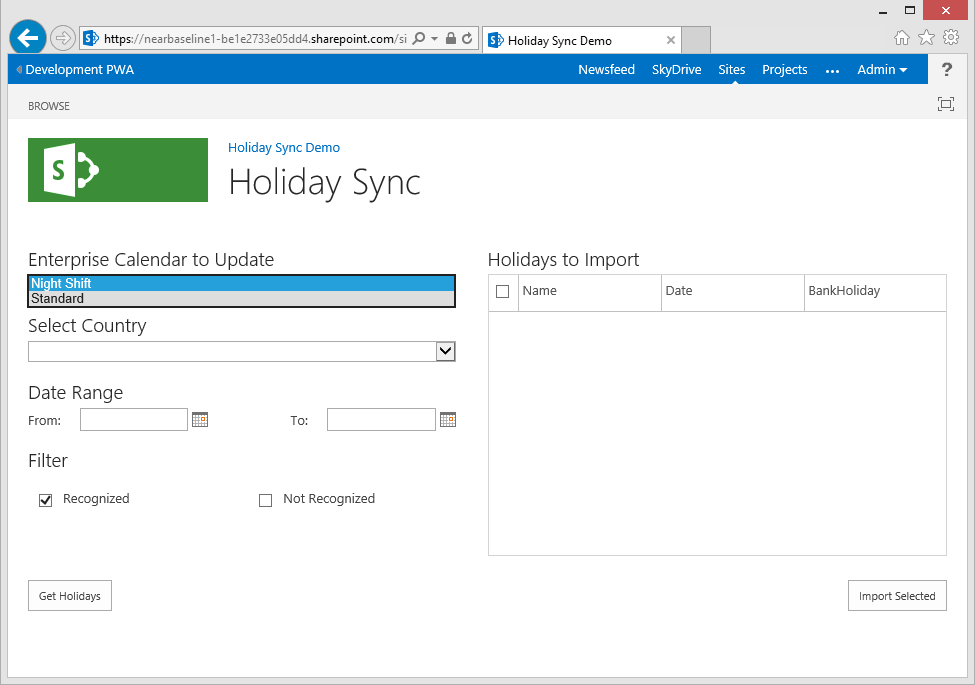
Our first drop-down is populated!
Retrieving External Web Service Data
Next we need to work with our external data provider, in this case I am using www.holidaywebservice.com for our holiday data, the service is free and provided as-is and suits our needs here (assuming you’re in one of the supported countries!). However in order to utilise a 3rd party web service we have to consider cross-domain scripting restrictions inherent to JavaScript.
SharePoint cross-domain scripting library
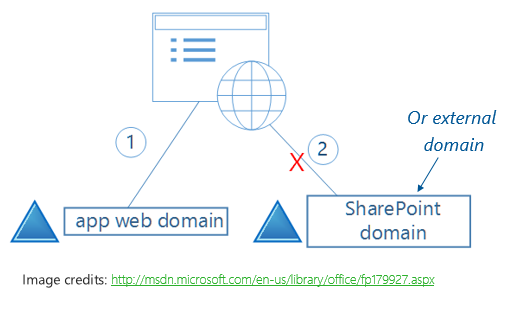
By design JavaScript which is running in a site in for example http://myapp.domain.com cannot communicate with data in something like http://someservice.com. This is to protect against a common vulnerability known as Cross-site scripting (XSS), so in order to use an external service we need to take extra steps.
Fortunately SharePoint provides us with a JSOM library that we can use to securely work with this restriction, it’s known as the Cross-domain scripting library, essentially it allows for our connection to be proxied via an endpoint in our app domain (in a SharePoint REST endpoint), therefore our request never leaves the current domain.
So the next piece of code we need to add to our App.js file is the following function;
// SharePoint Cross domain library helper function
HolidaySync.prototype.crossDomainCall = function (SPHostUrl, callUrl, successCallback, failureCallback) {
// Use the Cross Domain library
// Source: http://blogs.msdn.com/b/officeapps/archive/2012/11/29/solving-cross-domain-problems-in-apps-for-sharepoint.aspx
$.getScript(SPHostUrl + "/_layouts/15/" + "SP.RequestExecutor.js", Function.createDelegate(this, function () {
// First construct our JSOM request
var clientContext = new SP.ClientContext.get_current();
var crossDomainRequest = new SP.WebRequestInfo();
crossDomainRequest.set_url(callUrl);
crossDomainRequest.set_method("GET");
var response = SP.WebProxy.invoke(clientContext, crossDomainRequest);
// Execute our request with a callback function
clientContext.executeQueryAsync(Function.createDelegate(this, function () {
var statusCode = response.get_statusCode();
// HTTP status success / failure determines which callback function to send our results to
if (statusCode === 200) {
// JavaScript functions are first-class objects (how cool!)
successCallback(response.get_body());
}
else {
failureCallback(statusCode, response.get_body());
}
}));
}));
};
This helper function is one I sourced / adapted from Humberto Lezama’s blog Solving cross-domain problems in apps for SharePoint, essentially I have just parametized Humbertos’ work into a single function so that we can re-use it in the following functions in our solution.
Enable the Remote Endpoint in App Manifest
Before we can use the above function there is one thing we need to do, which is to add our external URL (http://www.holidaywebservice.com) into the app manifest under Remote Endpoints, as follows;
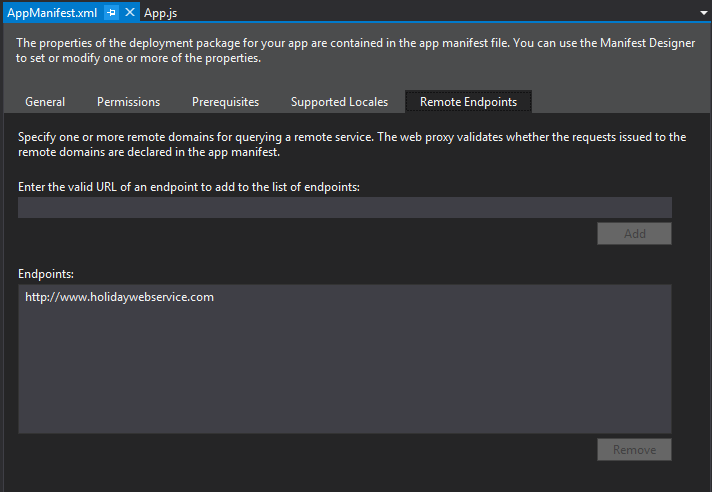
Retrieve a list of Countries from the external service
Next we need to populate our Select Country drop-down with a list of countries available from our service, to do this paste in the following function which uses our cross domain helper;
// Get available countries from the web service
// Source: http://www.holidaywebservice.com/
HolidaySync.prototype.getCountries = function () {
// Requires http://www.holidaywebservice.com in AppManifest Remote Endpoints
var url = "http://www.holidaywebservice.com/HolidayService_v2/HolidayService2.asmx/GetCountriesAvailable";
// Use the Cross Domain Helper
this.crossDomainCall(this.urlTokens.SPHostUrl, url, Function.createDelegate(this, function (response) {
// Save our data
var xmlData = $.parseXML(response);
//Using plugin: http://www.fyneworks.com/jquery/xml-to-json/
var jsonData = $.xml2json(xmlData);
this.data.countryCodes = jsonData.CountryCode;
// Populate our dropdown list of Countries when data is ready
for (var i = 0; i < this.data.countryCodes.length; i++) {
$("#countrySelect").append($('<option>', {
value: this.data.countryCodes[i].Code,
text: this.data.countryCodes[i].Description
}));
}
// Also set the default value
$("#countrySelect").trigger("change");
}), Function.createDelegate(this, function (status, error) {
// Handle failures
alert(error);
}));
};
So the above function looks very similar to the jQuery AJAX function used previously, in short we are passing the function some parameters including;
- Our SharePoint host URL – not the App web, this time we need the actual tenant URL
- Our full external URL including the SOAP call (see www.holidaywebservice.com for more info on that)
- Then finally we have our success and failure handlers.
Now in this case our web service is returning XML data, so we need to do some conversion, for which I’ve used a simple jQuery plugin (http://www.fyneworks.com/jquery/xml-to-json/) once converted we populate our drop-down and trigger change to set our default value.
Again as with our getEntCalData function we add the following to the end of our main code block to trigger the function on start:
holidaySync.getCountries();
Retrieve the Holiday Data from external service
Now we’re ready to get the holiday data itself, paste in the following function;
// Get Holidays from Web Service
HolidaySync.prototype.getHolidaysForDates = function (fromDate, toDate, country) {
var startDate = new Date(fromDate);
var endDate = new Date(toDate);
var url = "http://www.holidaywebservice.com/HolidayService_v2/HolidayService2.asmx/GetHolidaysForDateRange" +
"?countryCode=" + country + "&startDate=" + startDate.toISOString() + "&endDate=" + endDate.toISOString();
// Show a loading message
this.notifyMsg = SP.UI.Notify.addNotification('<img src="/_layouts/images/loadingcirclests16.gif" style="vertical-align: top;"/> Loading...', true);
this.crossDomainCall(this.urlTokens.SPHostUrl, url, Function.createDelegate(this, function (response) {
// Save our data
var xmlData = $.parseXML(response);
//Using plugin: http://www.fyneworks.com/jquery/xml-to-json/
var jsonData = $.xml2json(xmlData);
// Update the grid contents
Helpers.updateGridContents(jsonData.Holiday, this.data.holidayData, this.grid);
// Remove the notification msg
SP.UI.Notify.removeNotification(this.notifyMsg);
}), Function.createDelegate(this, function (status, error) {
// Handle failures
SP.UI.Notify.removeNotification(this.notifyMsg);
alert(error);
}));
};
You can see a few things happening there, firstly we are taking some parameters which will be populated with our to and from dates as well as our selected country, then once again we call the cross domain helper function with our constructed SOAP request.
Just one extra thing I have added to this function is the notification handlers, that’s using the SharePoint JSOM to display and remove a neat notification message during retrieval, so we don’t have any uncomfortable pauses in our UI.
Lastly handle our button click and preview!
Almost done now, only one thing left and that is to call the above function when we click the Get Holidays button! Paste the following event handler into our Main function;
// Button to get calendar exceptions
$("#getDataBtn").click(Function.createDelegate(this, function () {
if (!!holidaySync.data.fromDate && !!holidaySync.data.toDate && !!holidaySync.data.country)
holidaySync.getHolidaysForDates(holidaySync.data.fromDate, holidaySync.data.toDate, holidaySync.data.country);
else
alert("Please select dates.");
}));
Other than handling the click event we’re just doing some error checking to ensure all parameters are selected.
Done! Hit F5 to preview.
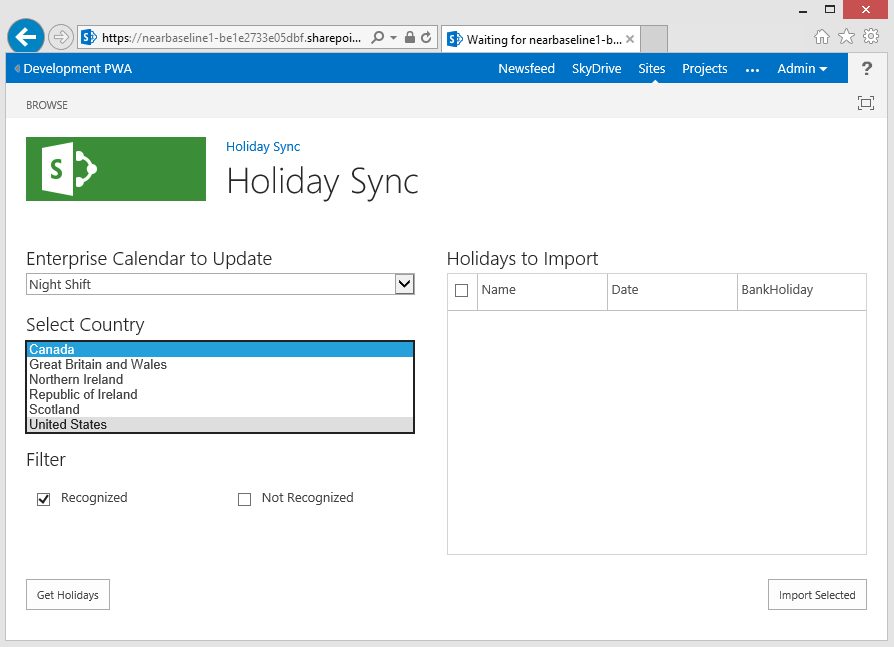
First select the country (cool!), then pick the to and from dates, then click Get Holidays:
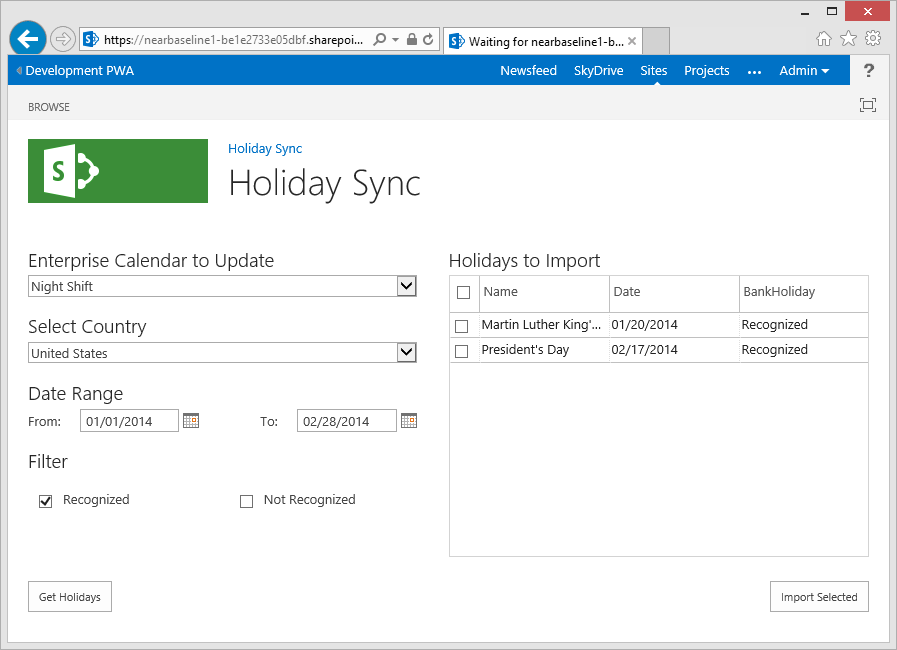
Nice.
Next up, part 3: Importing data into Enterprise Calendars from our App
Now that we have our holiday data we can finally update our enterprise calendars, check back really soon to see the final part of this series!
Source Download / Repository
Download the complete source to the above code here:
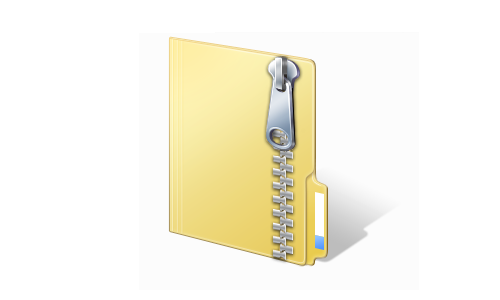
HolidaySyncDemo2.zip
Additionally for those of you who like to skip to the end of this series, you can browse or download the full source code for the completed app on the following GitHub repository:
https://github.com/martinlaukkanen/holidaysync
by Martin Laukkanen | Feb 7, 2014 | Apps, Development, How to
This is the first part of a three part series on extending project online / on-prem using JSOM, see this post for an index of all three parts to this as I write them.
Part 1: Getting started creating the Holiday Sync App
Let’s begin with a user story:
I want to import holiday exceptions into my enterprise calendars
Our solution:
We’re going to create a SharePoint hosted App for Project Server to do the following:
- List enterprise calendars in PWA
- Get holiday data from an external web service
- Allow us to select holidays to we want to import
- Provide an import button to perform the import
Here’s a quick wireframe created in PowerPoint to demonstrate what we’re trying to achieve (picture worth a dozen design docs?):

Software Requirements
To get started you’ll need a few things:
- Visual Studio 2012 (or higher)
I’m going to use VS2013 so you will need Visual Studio to work with the attached source files, but it would be possible to use the “Napa” Office 365 development tools or other tools for this.
- Web Essentials for Visual Studio
Highly recommended but not required.
- Development environment (either of these):
- Project Online subscription
- Local Project Server 2013 development server
Wherever you’re debugging, make sure to enable “sideloading” of apps on PWA via PowerShell.
And finally note that Project Online is not currently included in the Office365 developer subscription so you’ll need a Project Online tenant in that case, and I’d recommend creating a separate PWA instance for development as enabling side-loading changes the homepage and enables features which should not be enabled on Production sites.
Getting Started with our App in Visual Studio
The first step is to create our blank SharePoint app in Visual Studio:

Second, I’m using a Project Online instance for debugging, but wherever you use make sure to set SharePoint-hosted for the hosting type:

This will give you the vanilla SharePoint App template, setup for our SharePoint-hosted JavaScript app, great now let’s start adding what we need, first up libraries and add-ins.
Libraries and Add-in’s
For our app we will be adding the following:
- Project Server JSOM library (ps.js)
- jQuery – Used extensively throughout solution.
- jQuery UI – Used for the date picker UI controls.
- Slick Grid – Used for our results grid.
Plus a few miscellaneous plugins:
The main extra library used is the grid control (Slick Grid) where actually any grid would do here as our requirements are really simple (JS Grid maybe?), but I like Slick Grid as it’s free (MIT license) and it’s fast and super easy to setup and use.
So with that list in mind let’s update our Default.aspx file, insert the following below the sp.js script line:
<script type="text/javascript" src="/_layouts/15/ps.js"></script>
<script type="text/javascript" src="../Scripts/libs/jquery-ui-1.10.3.custom.min.js"></script>
<script type="text/javascript" src="../Scripts/libs/jquery.xml2json.js"></script>
<link type="text/css" href="../Content/jquery-ui-1.10.3.custom.css" rel="stylesheet" />
<link type="text/css" href="../Content/slick.grid.css" rel="stylesheet" />
<script type="text/javascript" src="../Scripts/libs/jquery.event.drag-2.2.js"></script>
<script type="text/javascript" src="../Scripts/libs/slick.core.js"></script>
<script type="text/javascript" src="../Scripts/libs/slick.grid.js"></script>
<script type="text/javascript" src="../Scripts/libs/slick.checkboxselectcolumn.js"></script>
<script type="text/javascript" src="../Scripts/libs/slick.rowselectionmodel.js"></script>
<script type="text/javascript" src="../Scripts/libs/slick.dataview.js"></script>
To download the files in the libs folder see the bottom of this article, or you could even download them directly from the links above.
HTML and Stylesheets
I’m not a front end developer so I’ll freely admit that the following two parts took me longer than the rest of this App to write! But looks are important so it’s time well spent I’d say.
HTML for our Single Page App
Add this to the ContentPlaceHolderID=”PlaceHolderMain” section of the Default.aspx file;
<div class="HalfPage">
<div class="ContentPane">
<h2>Enterprise Calendar to Update</h2>
<select id="eCalendarSelect">
</select>
<h2>Select Country</h2>
<select id="countrySelect">
</select>
<h2>Date Range</h2>
<div class="DatePickers">
<div class="HalfPage">
<label>From:</label>
<input type="text" id="fromDatePicker" />
</div>
<div class="HalfPage">
<span class="RightHalf">
<label>To:</label>
<input type="text" id="toDatePicker" />
</span>
</div>
</div>
<h2>Filter</h2>
<div id="filterInputs" class="FilterOpts">
<ul class='listColumns'>
<li><input id='Recognized' type='checkbox' value='Recognized' checked='checked' />Recognized</li>
<li><input id='NotRecognized' type='checkbox' value='NotRecognized' />Not Recognized</li>
</ul>
</div>
</div>
</div>
<div class="HalfPage">
<h2>Holidays to Import</h2>
<div id="grid" class="grid"></div>
</div>
<div>
<input type="button" id="importBtn" class="ImportButton" value="Import Selected" />
<input type="button" id="getDataBtn" class="RetrieveButton" value="Get Holidays" />
</div>
So in our HTML, we need a two column page with our required select and input elements with labels to identify them and also I’ve included the required filter options based on our holiday web service which will come back to later. That should be dynamic like the other controls which will be created in the JavaScript but that suits our purposes for now. Finally we have Div place holder for our grid control and some action buttons.
Most of the base styling including headers, fonts and labels are borrowing the SharePoint default styles available so the intention is to have our app look like native SharePoint / Project functionality. For the grid and other classes used I have a bit of CSS to add to the SlickGrid Excel style css theme that is available for that library, but I have modified it a bit as you can see in the CSS.
CSS Style Sheet
Place the following in the App.css:
.HalfPage {
width:50%;
float:left;
}
.HalfPage h2 {
clear: left;
padding: 16px 0 4px;
}
.ContentPane {
margin: 0 32px 16px 0;
}
.ContentPane select {
width:100%;
}
.DatePickers label {
margin-right: 16px;
}
.DatePickers input {
width: 45%;
}
.RightHalf {
float:right;
text-align: right;
}
.ui-datepicker-trigger {
vertical-align: middle;
padding-left: 4px;
}
.FilterOpts input {
margin: 0 8px;
}
.ImportButton {
margin-top: 24px;
float:right;
}
.RetrieveButton {
margin-top: 24px;
float:left;
margin-left: 0px !important;
}
.listColumns {
-moz-columns: 2;
-webkit-columns: 2;
columns: 2;
list-style: none;
padding-left:0px;
}
#grid {
outline: 0;
border: 1px solid lightgrey;
height: 280px;
}
.slick-viewport {
overflow-x: hidden !important;
}
.slick-header-column.ui-state-default {
padding-top: 6px;
height: 26px;
}
.slick-header-columns {
border-bottom: 1px solid silver;
}
.ui-state-default {
border: none;
background: none;
font-family: "Segoe UI","Segoe",Tahoma,Helvetica,Arial,sans-serif;
font-size: 13px;
}
.ui-widget {
font-family: "Segoe UI","Segoe",Tahoma,Helvetica,Arial,sans-serif;
font-size: 13px;
}
Before you comment on my ugly CSS, lets just move along! :)
Helper.js JavaScript helper script
I’ve separated out our App code into just two files to keep this simple, the Helper.js file includes a number of functions that do as the name suggests, things like browser compatibility shims are ideal here as we will load this file before our main JS file.
Summary of helper functions:
- Date.prototype.toISOString() – Used to support IE8 as it doesn’t support the ISO date string format.
- Helpers.urlToArray() – Used to convert our URL query strings into an array of key / values.
- Helpers.setupGrid() – The first part of our Slick Grid code used to setup the grid and required plug-ins.
- Helpers.bankHolidayFilter() – Our Slick Grid filter function.
- Helpers.dateTimeFormatter() – Our grid date formatter, for this I have hard coded to US format, but I would suggest using a library like Moment.js to help do this properly for all regions.
- Helpers.updateGridContents() – Used to update our grid once we have transformed our holiday data as required.
Create a new file in your solution called Helpers.js and add the following;
'use strict';
///
/// Helpers
///
// Shim for IE8 to support date formatter
if (!Date.prototype.toISOString) {
(function () {
function pad(number) {
if (number < 10) {
return '0' + number;
}
return number;
}
Date.prototype.toISOString = function () {
return this.getUTCFullYear() +
'-' + pad(this.getUTCMonth() + 1) +
'-' + pad(this.getUTCDate()) +
'T' + pad(this.getUTCHours()) +
':' + pad(this.getUTCMinutes()) +
':' + pad(this.getUTCSeconds()) +
'.' + (this.getUTCMilliseconds() / 1000).toFixed(3).slice(2, 5) +
'Z';
};
}());
}
// Static helper class
var Helpers = function () { };
Helpers.urlToArray = function (url) {
var request = {};
var pairs = url.substring(url.indexOf('?') + 1).split('&');
for (var i = 0; i < pairs.length; i++) {
var pair = pairs[i].split('=');
request[decodeURIComponent(pair[0])] = decodeURIComponent(pair[1]);
}
return request;
};
/// Grid helpers
// Setup our Grid
// Using https://github.com/mleibman/SlickGrid
Helpers.setupGrid = function (grid, options, columns, data) {
var checkboxSelector = new Slick.CheckboxSelectColumn({
cssClass: "slick-cell-checkboxsel"
});
columns.unshift(checkboxSelector.getColumnDefinition());
grid = new Slick.Grid("#grid", data, columns, options);
grid.setSelectionModel(new Slick.RowSelectionModel({ selectActiveRow: false }));
grid.registerPlugin(checkboxSelector);
data.setFilter(Helpers.bankHolidayFilter);
return grid;
}
// Grid filter function
Helpers.bankHolidayFilter = function (item, args) {
var inArray = $.grep(args.BankHoliday, function (value) { return value === item.BankHoliday; });
if (inArray.length > 0) {
return true;
}
return false;
};
Helpers.dateTimeFormatter = function (row, cell, value, columnDef, dataContext) {
// Basic US date formatter with fallback to ISO
var dt = new Date(value);
if (isNaN(dt))
return value.split("T")[0];
else
return dt.format("MM/dd/yyyy");
};
// Update the grid contents
Helpers.updateGridContents = function (holidays, gridData, grid) {
// Setup grid filters
gridData.setFilterArgs({
BankHoliday: $("#filterInputs input:checked").map(function () { return this.value; }).get()
});
// First need to add a uniquie identifier to the data set (to support SlickGrid filtering)
for (var i = 0; i < holidays.length; i++) {
holidays[i].id = i;
}
// Now use the data
gridData.setItems(holidays);
// Redraw the grid
gridData.refresh();
grid.invalidateAllRows();
grid.render();
grid.resizeCanvas();
}
Finally we have a remove duplicates function that I will go into a little more detail on as it relates to our JSOM import that we’ll be adding later, so add the following function to the end of the Helper.js file.
// Remove duplicate calendar exceptions
Helpers.removeDuplicates = function (selectedRows, data) {
var exceptionsToImport = [];
// Use jQuery grep function to get our selected enterprise calendar
var entCalendar = $.grep(data.entCalendars, function (cal) {
return cal.Id === data.calendarId;
})[0];
// Prepare the array of exceptions excluding duplicates
for (var i = 0; i < selectedRows.length; i++) {
// Get this selected row from the Grid
var selectedHoliday = data.holidayData.getItem(selectedRows[i]);
// Ensure that our exception date does not overlap with any existing exceptions
var alreadyExist = $.grep(entCalendar.BaseCalendarExceptions.results, function (excep) {
return excep.Finish <= selectedHoliday.Date && excep.Start >= selectedHoliday.Date;
});
if (alreadyExist.length === 0) {
// Last check to make sure we don't add the same date twice
var newException = $.grep(exceptionsToImport, function (item) {
return item.Date === selectedHoliday.Date;
});
if (newException.length === 0)
exceptionsToImport.push(selectedHoliday);
}
}
return exceptionsToImport;
}
From testing it was clear that the following preconditions in Project Server exist which affect our app;
- No exceptions can overlap in a single base calendar.
- All exceptions must have a unique name in a single base calendar.
So our remove duplicates function ensures the above by doing the following;
- First looping through our selected rows array.
- Getting the item in each row and getting a reference to our enterprise calendar.
- Comparing the Start and Finish dates of our exception to ensure they do not overlap with any existing BaseCalendarExceptions (note that we’ll be populating this data in Part 2 of this series) – I’m using the jQuery Grep function for this as it’s quite flexible for this kind of thing.
- Then finally add this exception to our output array, after a quick check to ensure that we haven’t already added it with another name.
Now that we have all of our helpers in add a reference to the Helper.js file in the Default.aspx pointing to wherever you created your file, for example:
<script type="text/javascript" src="../Scripts/Helpers.js"></script>
Note: Ensure that the above line is placed ABOVE the App.js script reference!
App.js Main JavaScript file outline
For now we only have our basic structure and functionality in here, specifically I’m using the constructor prototype pattern in JavaScript here to clearly define our namespace and structure our code accordingly, trust me it might look more complex compared with many examples out there, but once you start working with asynchronous event based functions you really need to know where your this is! (Not to mention keeping the global context clean)
///
/// Namespace & constructor
///
var HolidaySync = function () {
// Instance data
this.urlTokens = Helpers.urlToArray(location.href);
this.data = new HolidaySync.DataModel();
// Grid configuration
this.grid = undefined;
this.columns = [
{ id: "Name", name: "Name", field: "Descriptor" },
{ id: "Date", name: "Date", field: "Date", formatter: Helpers.dateTimeFormatter },
{ id: "BankHoliday", name: "BankHoliday", field: "BankHoliday" }
];
this.options = {
enableCellNavigation: true,
syncColumnCellResize: true,
forceFitColumns: true
};
};
So our first few lines to add to App.js declare our namespace and some instance properties, most of which relates to our Slick Grid (options and columns etc). We also have an instance of our DataModel instantiated which is done using the following function;
///
/// Data Model
///
HolidaySync.DataModel = function () {
this.entCalendars = {};
this.countryCodes = {};
this.calendarId = '';
this.country = '';
this.fromDate = '';
this.toDate = '';
// Grid data
this.holidayData = new Slick.Data.DataView();
};
Now that we have our “Public properties” I have a main function at the top with just a few lines for the moment:
///
/// Main code block, begin once the DOM is loaded
///
$(document).ready(function () {
// Instantiate our object
var holidaySync = new HolidaySync();
// Setup our Grid
// Using https://github.com/mleibman/SlickGrid
holidaySync.grid = Helpers.setupGrid(holidaySync.grid, holidaySync.options, holidaySync.columns, holidaySync.data.holidayData);
// Setup our page controls and events
holidaySync.setupPageControls();
});
In there we instantiate our namespace defined above, then start calling some helper functions to setup our grid (defined in Helpers.setupGrid()) and then to setup our page using the following function:
// Function to wire-up our UI
HolidaySync.prototype.setupPageControls = function () {
// Create our jQuery UI Date picker controls
$("#fromDatePicker").datepicker({
showOn: "button",
buttonImage: "/_layouts/15/images/calendar.gif",
buttonImageOnly: true,
onSelect: Function.createDelegate(this, function (dateText) {
this.data.fromDate = dateText;
})
});
$("#toDatePicker").datepicker({
showOn: "button",
buttonImage: "/_layouts/15/images/calendar.gif",
buttonImageOnly: true,
onSelect: Function.createDelegate(this, function (dateText) {
this.data.toDate = dateText;
})
});
// Setup our page event handlers
$("#countrySelect").change(Function.createDelegate(this, function (event, data) {
this.data.country = $("#countrySelect option:selected")[0].value;
}));
$("#eCalendarSelect").change(Function.createDelegate(this, function (event, data) {
this.data.calendarId = $("#eCalendarSelect option:selected")[0].value;
}));
};
This function is all jQuery and creates our date pickers and change events on our drop-down select boxes. Note the context here, ie this.data.*** as we are on our prototype these controls asynchronously update our DataModel in this instance (hence why this is not in the static helper class).
With the above added you should now be able to preview the app! Nothing much will happen yet, but it should look pretty complete visually and all of our controls should function:

Next up, part 2: Getting data into our Holiday Sync App
Now that we have our App structure, next we need to work with some data, so check back in the next day or so for Part 2 of this series.
Source Download / Repository
Download the complete source to the above code here:

HolidaySyncDemo1.zip
Additionally for those of you who like to skip to the end of this series, you can browse or download the full source code for the completed app on the following GitHub repository:
https://github.com/martinlaukkanen/holidaysync
by Martin Laukkanen | Dec 26, 2013 | Apps, How to, Project Online
I’ve been recently moving the last few components of my setup into the cloud and the last piece is decommissioning my development server, however not having full PowerShell access does place some limits on what can be done on Project Online so this particular error initially had me stumped:
Error occurred in deployment step ‘Install App for SharePoint’: Sideloading of apps is not enabled on this site.
On-premise that can be fixed as easily as:
Enable-SPFeature e374875e-06b6-11e0-b0fa-57f5dfd72085 –url http://server/PWA
(Source: http://blogs.msdn.com/b/josrod)
However as Tobias Lekman points out to do this on Office 365 or Project Online you need to use another method. Unfortunately the script you need: http://lekman.codeplex.com/releases/view/98505 appears to have an old GUID, so a slight modification is needed.
Steps to setup Project Online for App development
- First provision your PWA instance from the SharePoint Admin site, I’m going to use /sites/devpwa for this example.
- Download the Sideload.ps1 script.
- Open the script and replace the following line:
$sideLoadingGuid = new-object System.Guid "AE3A1339-61F5-4f8f-81A7-ABD2DA956A7D"
#Replace above line with:
$sideLoadingGuid = new-object System.Guid "e374875e-06b6-11e0-b0fa-57f5dfd72085"
- Now run the modified script and follow the prompts, for example:

Now your PWA site should look quite different:
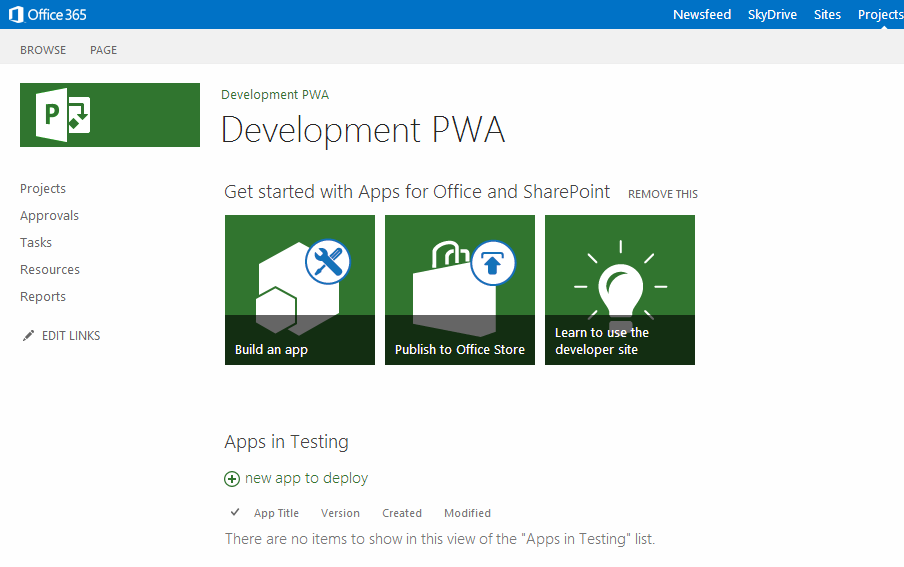
Now you can deploy from Visual Studio without errors and debug as you would on-premise.
Note: Obviously you don’t want to do this on a Production PWA instance, for Production sites only ever use an App Catalog to deploy manually.
Office 365 developer subscription limit
Lastly, one thing that irritates me is that the O365 MSDN Dev subscription does not include Project Online! So please join me every opportunity you get to speak to your contacts in MS about fixing this serious omission!





































